#and most of it has to have a lot of environmental elements
Explore tagged Tumblr posts
Text

OOT/FF7 ART FINALLY....... this is specifically supposed to show off a main thing that'd frequently happen in it where sephiroth and ganondorf sneak off at night just to talk to eachother (sephiroth isnt supposed to do that. bc of rules for soldiers ill explain soldier stuff another time) but yeah. hope u guys enjoy this vague post bc its all youll be getting of this au for the next few weeks probably. sorry..
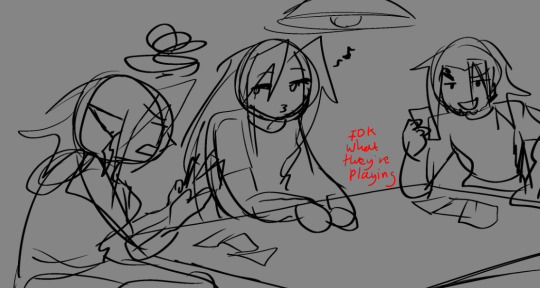
and bonus drawing of genesis, angeal and sephiroth playing some card game Smile
#my art#ff7#oot#ocarina of time#sephiganon#sephiroth#ganondorf#oot ganondorf#ootff7 au#alternate universe#crossover#whatever I also made this to get back into drawing backgrounds again.......#i really wanna make a bunch of art to go alongside my auposting#and most of it has to have a lot of environmental elements#hence why. i have taken a while to post abt it again#if anyone wants more lore or whatevs please. PLEASE LET ME KNOW#ill try and make smaller drawings if anyone really really wants more info#crackship#I CANT BELIEVE I FORGOT THAT TAAGGG
21 notes
·
View notes
Text
Top 10 Scariest Color/Gene Combos (Part 1/2)
Long post... Be prepared for a fright under the cut 😈
10. Lead Tide


Environmental contamination. What are we doing to our oceans. Tidelord would be disappointed. And also full of lead. (Have dragons invented microplastics yet?) Anyways do not drink these guys especially if you are a baby or something like that.
9. Fire Wasp


Many people are afraid of bees, and many more are afraid of wasps. While both may or may not be able to sting you (depending on species), and one is ultimately a subtype of the other, even people who think every bug is so cool and so cutes might get scared if they had mastery over the element of fire (and can still sting you). I think if a wasp could burn you, it would hurt a lot, and they might also be impervious to fire and smoke as a deterrent. I suppose they could just have a particularly "spicy" venom instead? Good thing there aren't any species of wingless wasp (ant) known for a fiery venom that are prone to being highly invasive in much of the United States and abroad! (Editor's Note: Fire ants are real and can hurt you. For most people in most situations, this is usually an inconvenience more than anything.)
8. Orca Thylacine


A hybrid between an orca and a thylacine would probably be a capable predator on land and at sea, as well as tolerate a broad range of climates. Furthermore, it would have both the motive and the intelligence to enact revenge on humanity or whatever. Has science gone too far?
7. Pumpkin Phantom


Oh no, it's the scary Halloween guy! With an epithet like "phantom," you can be sure this undead dragon is down for some mischief and haunting. Maybe even some shrieking and terrorizing! It may not be the scariest concept on the list, but it isn't for lack of trying. If rates of fatal decapitation spike in your area, we know who to blame...
6. Shadow Clown


Look out! It's Problems the Evil Shadow Clown, from those TikTok animations! Or maybe it's actually Problems the Regular Shadow Clown, who knows? But both clowns and the dark are scary to many people, so a clown *of* darkness? That is probably the scariest thing someone on Earth could imagine. Anyways I'm pretty sure this guy has some sort of Weapons or Dark Powers regardless. (You can also make this entry a joke about juggalos, if you want.)
#flight rising#fr#flightrising#fr scrying workshop#halloween#scary#frightening#eye horror tw#violence tw#fucked up and evil tw#part 2 coming soon. very
143 notes
·
View notes
Note
Do you know of a ttrpg where travel is the main focus? Like I tried one ring and travel felt like a mini game rather than a key feature
THEME: Travel (Part 2)
Hello friend, so I’m firstly going to link you to this Travel Recommendation Post I put together in June of last year. (It’s a lot of posts and I didn’t tag it very well! Working on remedying that.)



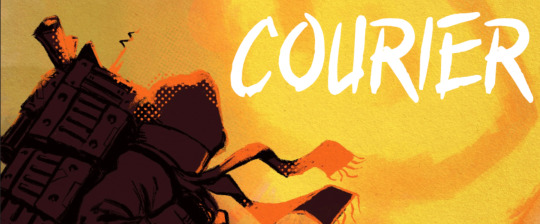
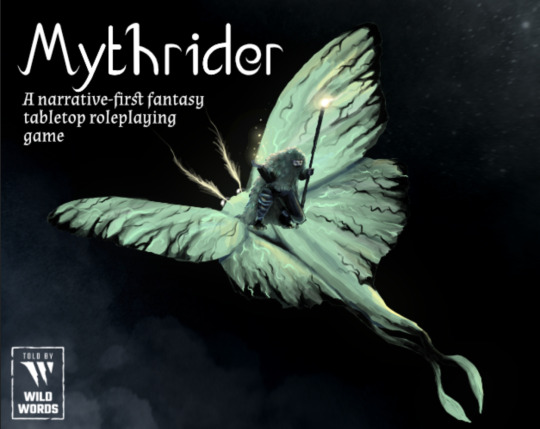
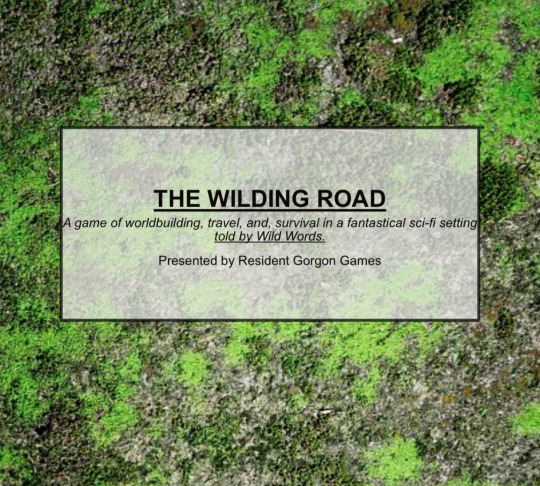

Rig Rats, by kyusenbo.
The year is 30XX, and climate disasters and human negligence have brought the world to its knees. Only large, corporation-run cities remain, surrounded by large, climate-controlled domes. However, in order for these corpo cities to send and receive goods and services between each other, we need Rig Rats. These are ragtag teams of big rig operations rogues, needed to run rigs on the desert roads, to ensure that these deliveries make it on time through radar attacks, bad weather, and poor road conditions.
Rig Rats takes prime inspiration from Mad Max, and while the game itself is just two jpeg images with a list of rules and a few scribbles, just by reading it I think it can deliver that kind of high-octane experience. Each of your characters has a role on the rig, such as Driver, Mechanic, or Lookout. You get to decide what you’re carrying, and why your cargo makes things complicated.
Each session is a single trip from one city to another, so it makes the game great for one-shots, and the number of obstacles that can come up make your trip truly harrowing. Will the rig break down? Will you run into rival bandits that want your cargo? What about environmental hazards, like minefields or electrical storms? What if a singular guy in a really modded-out car shows up and kicks the shit out of you because he wants your gasoline?
Anyways, you should check out Rig Rats.
Gone Too Far, by The Badger’s Den.
Gone Too Far is a GM-less rules-lite narrative game about travelling to distant planets. It can be played as a solo journaling game or as a collaborative roleplaying game for up to three players.
Far in the future, mining & scientific corporations send scouts to distant places to find suitable expansion locations or useful resources. They use a risky teleportation technology that is high risk / high reward, as there is a chance the user will go out of range for a return journey.
You (and your friends if playing together) play as one of these scouts going to lost places and mineral-rich planets.
While much of this game is exploration-focused, the danger of travelling too far is central to the premise. You are voyaging to new and wondrous places with heavily experimental and limited technology; the possibility that you don’t make it back makes the portal roll incredibly important to the game, even though it only happens at the end of a player’s trip. You play this game over and over series of rounds; the player experience can be rather siloed from other people at the table, unless you choose to use an optional aid mechanic. As a result, I think Gone Too Far might work rather well as a solo or duet game, and is a great option to consider if you like themes of travelling through space.
Ferryfolk, by cthos
Another day, another fare, another series of mysterious islands to traverse. You are a Ferryfolk, though there are those who call you by an older name: Psychopomp. Your job is to guide lost souls down the river Styx and see them to their final destination unharmed and hopefully having learned a life lesson or two.
Only the weirdest and most difficult cases draw multiple Ferryfolk to a single boat, and you've been selected for the job! Travel from island to island facing the Fare's fears and memories and guide them to be a better person before they reach their Destination.
As a 24XX game, Ferryfolk is rather rules light, with everything you need to play in just 5 pages. It carries elements I typically associate with the OSR (roll-tables, high amounts of danger, upgrades in the form of gear), as well as elements I typically associate with story games. The primary piece that feels story-like is rooted in the cargo your characters are ferrying across the River Styx: people.
Your passengers have personal problems that they’re wrestling with, and part of your journey must include visiting various islands, which contain memories that the passenger must work through if they are to overcome their personal fears. These passengers have a fear track, and risk becoming lost should they run into the wrong kind of hazard.
The fact that your boat has a distinguishing ability that gives it a unique advantage, as well as potential companions that can make your journey easier, makes this game both solo-friendly and suitable for a small campaign. If you liked the video game Spiritfarer, I think you might like Ferryfolk.
Courier, by Sleepy Sasquatch.
Courier is a solo-RPG where you take control of a Courier—someone who travels the Wasteland delivering and trading cargo in exchange for REP, the currency of this post-apocalyptic future. As you explore the world around you, locations and factions are revealed and recorded on your map. Choose to take jobs for factions and build reputation to access new benefits all while becoming better at your job and earning new character perks.
You will continue to take on quests delivering, recovering, or scouting the map for one of the many factions populating the Wasteland. Every choice you make as a Courier will reflect how these factions view you and open new opportunities and bonuses as your standing increases, or decreases through a fame and infamy system. Choices will have you siding with a few select factions by the end of your game and seeing the world change for it.
If you are a big fan of Death Stranding, I think you might like Courier. The game is all about exploring a wasteland and delivering items from one location to another. The game involves revealing hexes and tiles, so moving in a certain direction on the map can have really big consequences.A really large chunk of the game is focused on exploration, and that includes creating routes and shortcuts between locations: basically, improving your map to make future quests easier to complete. New locations give you both obstacles and opportunities, with both hazards and interesting scavenge that might be useful in keeping you alive.
The designer for Courier also has an updated version of this game called Courier - Repacked Edition, which they are very proud of - however I don’t own a copy of that game so I don’t know what exactly has been changed in the second version.
MythRider, by Natalie Jones.
When the great fires died and the distant reaches of civilisation were plunged into darkness, Riders were called upon to chart the dark. Explore the uncharted wilderness of a supernaturally huge forest, call forth legends into the world and bend magic through the wings of dragonflies.
Mythrider is a rules-light fantasy roleplaying game using the Wild Words engine to tell stories about knightly heroes and their giant insect steeds.
Like Wildsea, which uses the same system, MythRider has a whole type of scene dedicated to travel. Typical of a Wild Words game, you have a danger track that fills every time you run into trouble or move too fast, and a distance track to indicate how far you have to go before you reach your destination.
Games like this aren’t incredibly granular when it comes to any specific mechanic; many parts of the story can be abstracted out, including a montage that you can partake in whenever your crew has downtime at a settlement. This abstraction means that you can draw out the moments that mean the most to you, especially travel.
The setting for Mythrider is fantastical, with a really iconic set-piece of gigantic dragonflies and other insects that you can ride. I think these unique setting pieces make the game a compelling sell to any interested game group.
Wilding Road, by Resident Gorgon Games
Aldea was once a far flung colony of Earth. The people lived easy, carefree lives in a society fueled by clean, renewable energy and maintained by a benevolent AI known as the Overseer. Until the Collapse.
Something went horribly wrong with the gate in orbit, causing it to shatter and bring ruin to the world below. The lucky ones were able to escape and build a life on Aldea’s moon, Duru. Those left behind struggled to survive and what remained of the Overseer and Aldea’s infrastructure fought to return the planet to the garden it had once been.
Caravaners make a living by traveling between these pockets of society and civility. But, the road makes for a hard life. Even with beasts and bandits, the Overseer is constantly on the look out for those that would disturb its work of returning Aldea to what it deems as perfect. So, Rigs must walk the line of being able to travel but go unnoticed by the world around them, lest they be discovered and draw ire.
Wild Words games are typically great about travel: in this case, you also have the added difficulty of moving from point A to point B without getting noticed by something big and powerful.Your characters have a rig, which you use to cross the weird wilderness. You have a threat track, which is marked whenever the Rig runs into trouble, and eventually will likely introduce a hazard of some kind. You also have resources, in the form of both cargo that you are carrying and scrap you might discover, which can make the journey easier.
The designer for this game is doing a lot of work with this engine, making Realm, a fantasy game about exploring a world of spirits and wonder. If you like the ideas presented in Wildsea, you might want to check out these games!
Aquanautica, by Old Grog
Aquanautica is a subaquatic sci-fi setting inspired by the Aquazone Lego sets from the ‘90s. It takes place on Tethys-95, an oceanic, alien world filled with mystery and adventure. It was designed for use with tabletop roleplaying games but is system-agnostic and therefore doesn’t require any specific game system to play.
Aquanautica is a hex crawl setting that has a very colourful and useful map. This map has icons to represent different locations and environment types, as well as a colour reference to represent how deep you are at any given hex. The game comes with some dangers: running out of power or oxygen can bring your journey to a pretty definite end, and it will also make your navigation incredibly important: how far or deep can you go before you need to turn back?
The game has a lot of tools to help generate the setting and make it feel alive: there’s a roll table for encounters, some factions that will be trying to lay claim to parts of the setting, and a creature generator. There’s also a cave system generation process, which includes tunnels and additional dangers of getting lost and racing against the to find the exit.
This isn’t a game in itself - it’s an adventure setting for another game. I think a game like Mothership, Into the Odd, or perhaps a Tunnel Goons hack would be appropriate systems for Aquanautica.
Other Recommendation Posts To Check Out
My Isolation and Desperation post which had some funky recommendations for a person looking to craft a spooky road-trip.
My Pacific Drive Recommendation Post.
My Exploration recommendation post.
57 notes
·
View notes
Text
Elemental Masters in the movie-verse headcanons
Morro - Lloyd Garmadon's emo cousin and a college student who is kind of in a gang that commits a few crimes here and there, which is fine because people already assume he's evil for being related to Lloyd
Skylor - She inherited Chen's Noodle fortune after her father went to prison under mysterious circumstances. Has the best cooking in home ec class. It's even better than Zane's. She and Nya are an unstoppable duo in gym class
Griffin Turner - He's the substitute gym teacher at Ninjago High that everyone has a love-hate opinion of because he always, always makes everyone run a mile and doesn't let anyone get away with slacking, but he's also funny and somehow pretty chill
Karlof - Owns a popular metalworking shop and is a part-time substitute shop teacher at Ninjago High. Nya and Jay are his favorite students
Neuro - He's a defense lawyer. He's always able to call a bluff, and it never fails to frustrate the opposing counsel
Shade - She's a professional private investigator. One of the reasons that he's so good at his job is that no one can EVER spot him
Camille - She's a professional special effects makeup artist who always does the best onscreen effects
Krux - He's basically Ricky Geravis' character from Night At the Museum but a lot angrier, and also seconds away from firing his brother. Death glares at anyone on their phone
Acronix - He's a security guard at the museum who is always playing on his phone too loudly. Would have been fired several times over if his brother wasn't the curator
Bolobo - He's an environmental activist who may or may not have committed some minor crimes against major oil and energy corporations
Tox - She's a pharmacy manager who is very obviously into some shady stuff, but the rest of the staff turn a blind eye to it because she's the most knowledgeable person there
Jacob Pevsner - He owns a music studio next door to Dareth's dojo. Has banned Dareth from going anywhere near the music equipment
Ash - He's a firefighter. He's very good at his job, but nobody likes him because of his personality
#morro wu#ninjago morro#skylor chen#griffin turner#ninjago griffin turner#ninjago karlof#ninjago neuro#ninjago fanart#ninjago shade#ninjago camille#ninjago krux#ninjago acronix#ninjago bolobo#ninjago tox#ninjago ash#jacob pevsner#lego ninjago movie#ninjago movie#ninjago#ninjago headcanons#feel free to add on
103 notes
·
View notes
Text
I think there are a lot of people on the left who WANT all the antisemitic conspiracy theories to be true for exactly the same reasons a lot of people on the right do.
There are lot of people who WANT it to be true that "billionaires" is synonymous with "Jews"; that the greedy "elite" can be identified by demographic data. Who WANT it to be true that both major US political parties are the same because in the end, they're all part of the same unified hive mind of greedy power-mad misanthropic mutant lizard people - figuratively or literally, doesn't matter. Who WANT it to be true that all of Israel's few allies are ultimately just puppet governments of theirs (even though the opposite is much closer to being true), and the REST of the world is NEXT to fall to this horrible hive of evil.
Because, many people don't realize this, but conspiracy theories are PLEASANT to believe. It's exciting to think you're onto a deep truth that most people aren't privy to, especially when it sounds like something straight out of a scifi thriller. It's empowering to think the solution to all of society's ills is simple, staring you right in the face, and as soon as you just get enough people together to smash some crucial load-bearing element it will all come crashing down and lead us to our "natural state" of utopia like in an action-adventure epic. Even the helplessness of feeling like it's insurmountable has its own satisfying bent as a gateway to an extreme "positive" nihilism - if we're all fucked regardless, if (((their))) power is just too overwhelming, then nothing we do REALLY matters - we're free, we never have to do anything we don't want to again for the benefit of the world around us, because it won't change anything~!
Sound uncomfortably familiar yet? Perhaps like some arguments about voting, environmental protections, or local initiatives beyond libraries and public transit you've seen floating around right here on tungle dot hell? About the struggle of relating to "normies" and recognizing where the Overton window sits at any given time, even? About the prospects of getting ranked choice voting nationwide?
It doesn't matter who you are, or what your beliefs are, or how "smart" you are - at the end of the day we're all just hairless apes capable of falling for the same brain chemistry tricks as any other, and bullshit can be spun in leftist flavor just as easily as it can be spun to appeal to the right. You are not immune to the feeling of "awww yeah, it's all coming together~" over what you might realize, out of the moment, is a complete nonsequitur or cherry-picked to hell and back. You are not immune to the thrill of believing you're basically Neo The Matrix. It's hard to build resistance, let alone immunity, to the siren call of alleged easy solutions to complicated problems, or to the sweet relief of helplessness. The internet is doing a great job of making recreational outrage more and more appealing to more and more people.
I only beg more people to be willing to recognize those facts and TRY to course-correct when those feelings start to take them to some dark places.
105 notes
·
View notes
Note
Hey, I noticed that in one of your posts you showed an Iron Age Finnish woman's dress. Would you happen to have a good idea of what Finnish men were wearing in that era? The information on it seems sparse. I do have a relevant book that I'm about to look through, but I'd like to hear your insight too!
Hi! Thanks for the question (and sorry for the slow answer), I do love Finnish Iron Age clothing so it's always my pleasure to write about it. I've been wanting to do a deep dive into this for a long while, so maybe I'll do at some point a post about women's dress too.
Unfortunately no one has good idea of the Finnish Iron Age men's dress (and if you find any book or other source that claims otherwise, do not trust it), since there's much fewer archaeological finds of men's dress than women's dress. The most accepted theory on why the textiles of women's dress survived surprisingly well is because of the bronze ornamentation commonly sewn into especially the fine women's dresses of the era. The bronze protected them from decomposing fully. Presumably men's dresses were not decorated similarly then. There are some finds though and we can piece together at least some kind of vague picture.
I will be discussing the period from Viking Age to Crusade Age in Finland. Viking Age is often defined to cover 800s to mid-1000s and the Finnish Crusade Age started right after the Viking Age and ended in the end of 1200s, where the Finnish Medieval era begins. Crusade Age refers to the period where mostly Swedish (also German) crusaders in the span of couple of centuries conquered lands of the Baltic-Finnic pagans. The crusades of this period targeted pagans all over eastern Baltic Sea, including Baltic-Finnic Karelians, Livonians and Estonians, and Baltic peoples, and the Scandinavia too, where Sámi people were targeted. After that the Finland and Sápmi were colonized by Norse people and stayed that way untill Finland was transferred under Russian rule, but to this day Sápmi still stays under colonial rule, including Finnish colonial rule. The current Finland was very multicultural area, mostly populated by Finno-Ugric peoples, including Sámi people, Karelians and various Finnish peoples.
It's important to understand that even just Finnish peoples where not homogeneous, but had distinct, yet of course strongly related cultures. These were Finns (suomalaiset) (yes most people we now call Finns were not in fact called that) in the coast of southwestern and western Finland, Tavastians (hämäläiset) in central-western lake-Finland and Savonians (savolaiset) in central-eastern lake-Finland. This means we can't mix findings from all over Finland to reconstruct a dress without evidencing that all the elements were actually used in one place. These three tribes had broadly similar base for their clothes, but distinctive jewelry and detailing. The big divide was and has always been between eastern and western Finnish peoples. This is because western Finnish people were in close contact through the sea with Norse people and southern Baltic-Finnic peoples, while eastern Finnish people, Savonians mostly, were influenced a lot by their proximity with Karelians. Another dividing factor was the very different environmental conditions between western and eastern Finland. The Finnish coast especially in west is very flat and fertile land, while the lake area, especially in eastern Finland is very rocky, hilly and quite infertile. The main way it effected clothing differences was that western Finland being more wealthy had more elaborate clothing. Tavastians in both occasions fall quite in between, but they tended to be more in the western cultural camp.
My most important sources are a study by a doctor of cultural anthropology, Jenny Kangasvuo, Savon historia I (Savonian history) digitized and open sourced here and the digitized archeological collection of Finnish Heratage Agency. They are all in Finnish so not very useful for most people unfortunately.
Finnish Men's Dress in Viking and Crusader Ages
The basic garments men wore were broadly similar as women. They wore a shift/shirt, knee or above-knee length dress, cloak, belt, shoes and some kind of headwear. Wool was used most commonly, though the shirt would sometimes be linen too. Even evidence of silk has been found in some western Finland graves. I would assume that would be from a dress of some great man, who traveled to gain riches, possibly with vikings. Embroidery and decoration with metals was a typical feature of the whole Eastern Baltic Sea area. In Finland during this period bronze was the most common decorative metal, but silver was used too. Decorative elements were usually woven with small bronze spirals into all kinds of patterns. Here's examples from the reconstructed Ravattula's dress (Finns) used by women.
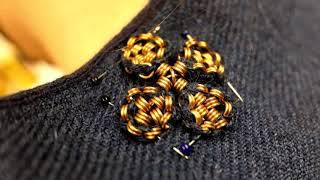
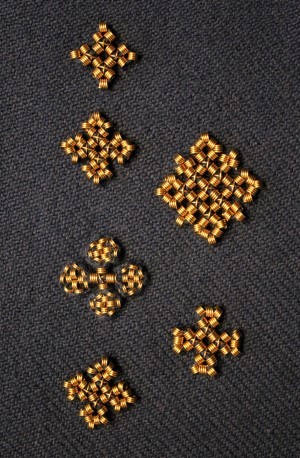
Shirt
The shirt (in Finnish shift of both women and men was called shirt) was basically a long shirt or under dress. We can assume it was similar to those of women's except shorter since the dress men wore was shorter too. They were made from wool or linen, I would assume wool was used in winter and linen in summer, when linen was even available. The neckline had a cut and closed with a bronze brooch. Horseshoe brooch was common. The first one is a quite typical bronze horseshoe brooch with a bit of ornamentation from Salo (Finns). The second one is from Tuukkala, (Savonians), it has exceptional ornate detailing and is uncommonly silver, not bronze. The third picture has two quite uniquely ornamented horseshoe brooches, first from Köyliö (Finns), second from Kurikka (Finns).
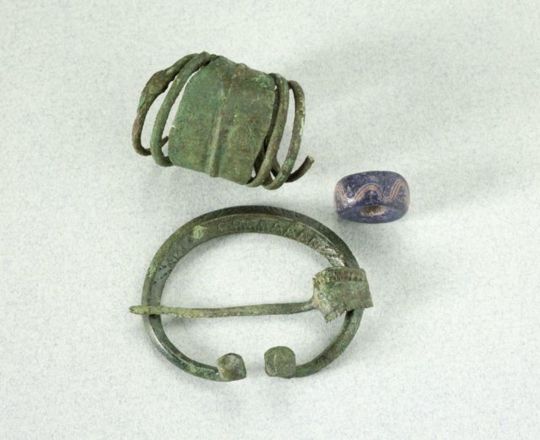


Legwear and footwear
Very little of men's legwear has survived and it's unclear weather men wore pants or separate pant legs, leg wraps or perhaps long socks. Evidence of strings decorated with bronze spirals and tablet woven band has been found in leg area of men's graves. This could mean that they wore either leg wraps, long sock or some sort of pant legs that needed to be secured with string or band under knee. Women used strings and tablet woven tape to secure leg wraps and socks, which I think supports that theory. Sometimes both bronze decorated string and tablet woven band was found in the leg area, which would still be explained by this theory, since it was common to decorate the ends of the bands with bronze decorated strings. Here's an example of sock bands just like that from the earlier mentioned reconstruction of the Ravattula's women's dress. Since men's dress was shorter, I think it would make sense if they still wore some kind of pants or separate pant legs with socks or leg wraps like that.

However, the strings and bands could have also been part of the shoes. Everyone probably wore similar shoes - laced leather shoes with a bit of pointed end. They might have been short or ankle length and the lacing was done with either leather cord or tablet woven band, which would also explain the findings. Socks or feet wraps would have been used in them, and straw or wool could be added as filling for warmth. Here's a pair of traditional Izhorian shoes from Estonia from early 1900s, and a pair of traditional Sámi shoes. The designs were likely roughly similar in Viking and Crusader Ages, though obviously more simple, and it's probable that Finnish shoes very something like that too. Here's a 1893 drawing of what findings of shoe material from Korpiselkä (Savonian or Karelian) might have looked like. Considering the quality of archaeology of that time, copious amounts of salt should be applied. And finally as a fourth picture there's reconstruction shoes from Ravattula's dress.
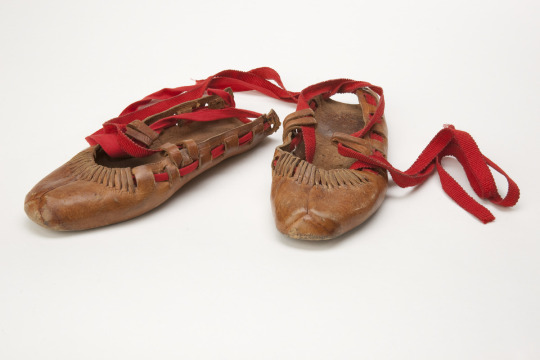
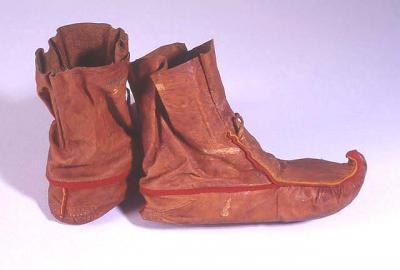


These are not necessarily mutually exclusive theories. The lacing of the shoe could have been laced up the leg and used also to secure either sock or leg wrapping, or they could have been separately secured in ankle and knee respectively.
In some graves twill fabric has been found in the leg area. It could be part of pants or for example leg wrapping, which was often made of twill. One theory about pants is that they were similar as some findings in Sweden, where fairly tight pants made of twill were secured at the hem with buttons similar to cuff studs. These kinds of cuff stud buttons are quite a common find in Finland and some have been found in men's graves close to legs.
Dress
Again there's not much findings of dresses, but a little more perhaps. It was usually from wool. The shape was either a tunic or an open coat. In Karelia there's findings of men's dress suggesting tunics thicker than women's dresses and made from sarka, a type of broadcloth. On the other hand, in Masku (Finns) they found buttons in a row on top of the torso, which suggest a coat closed with buttons. The first picture is a drawing of the grave find. Similary coak closing amounts of buttons have also been found in other places in western Finland. This suggests that Finns and probably Tavastians too wore long coats buttoned to the waist and Savonians wore tunic of Karelian influence. Below there's couple of version of what might this western Finnish men's coat dress could've looked like. The first is an imagined version of the coat based on the Masku grave finds, second is just as imagined version based on Eura (also Finns) grave finds.
Take these "reconstructions" with a strong dose of salt. These are more artistic reconstructions than scientific, since there's not enough material and too much guesswork needs to be done. And because we can see in the Masku grave drawing right here that the other deceased has a large buckle to (probably) close the shirt (to be fair, it could for a cloak too), like was typical, I find it implausible that the coat neckline would be small and round covering the buckle. If you make a decorated big buckle, I assume you want to show it. I would find a v-neckline more probable. It's also easier to make without wasting expensive fabric.


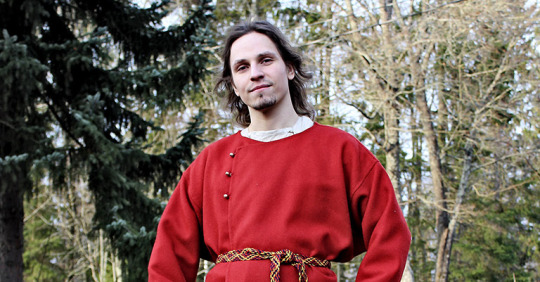
The buttons are interesting. There were what you would imagine - your typical buttons made of bronze like seen in the first artifact from Hattula (Tavastians). But then there was silver jingle bells used as buttons, found for example in both Masku and Eura graves, Eura findings pictured below.

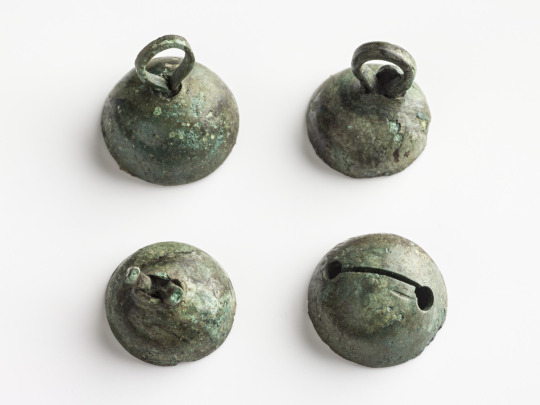
It's possible, even probable I'd say, that the hemlines of men's dresses were finished with tablet weaving patterns, like women's dresses. Also I would assume the pattern of the men's dress (and shirt) was mostly similar to the women's underdress/shirt patterns. So here's couple of different reconstruction patterns for women's dress. Different historians have made different interpretations of the patterns, so it's very much undecided what it really was like.


Belt
This is likely the most ornamental part of men's dress. They could be made out of leather or tablet woven band. And there's another east-west cultural divide here. Karelian belts were made out of leather, were usually 1,5-2,5 cm wide, decorated with iron or bronze studs and had a buckle made out of iron or bronze. These types of belts have been found in Savonia too, for example in Tuukkala grave find, which you can find very cool pictures of in this photo documentation of the dig in pages 173-175. In western Finland a "hela" belt was the common style. I don't think there's a world for hela in English. It's a sort of decorative lamella, small metallic plate (not necessarily square but often so) attached to fabric or leather with studs or sewing. Hela belt came from the Permians of Kama river, who were one of the many Finno-Ugric peoples who used to populate much of European side of Russia. Karelians lived closer to Permians, so you might think Permians would influence eastern Finland more, but my theory is that the costal Finns, who frequently joined viking crews and at least were in close contact with merchants including vikings, who would travel along the eastern route through the eastern European rivers, where they could go all the way to Kama river or at least meet traveling Permians. Here's yet another Finnish source more on the Finno-Ugric people around Kama river.
Anyway, hela belt was made of leather and filled with small decorated lamellas, often in square shape, but various other shapes too, like animal ornamentation. In this period hela belt helas were bronze. First image is a nice full set of hela belt metal pieces found in Pirkanmaa (Finns). Second is an older example, right before Viking Era, from Vaasa, costal settlement, (Finns), depicting a very Permian style. The third one is a lion hela found separately in Pälkäne (Tavastians). They are also found in Tuukkala, showing that both eastern and western cultural influences were present there at the same time.
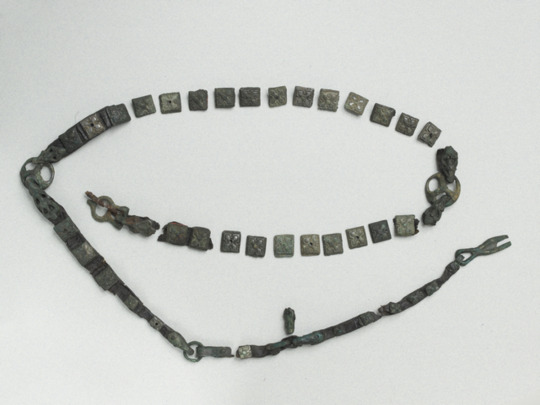
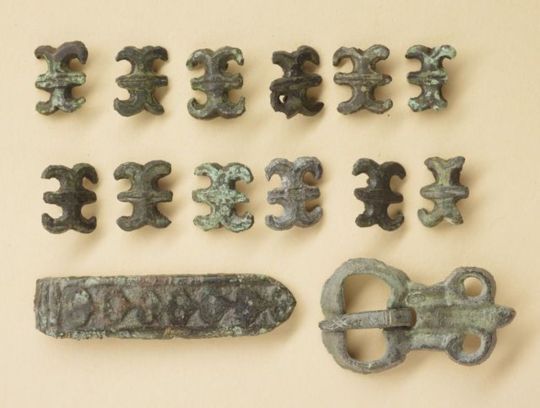

Another western Finnish belt type for men had intricate tassels decorated with bronze spirals hanging on the waist at the end of the belt. They could be made out of leather or tablet woven band. First image depicts a reconstruction of such tassel. Belts in east and west would have strap dividers to hang straps for things like purse, knife and sword. The first picture above has couple of those, but the second picture below has two more of them in more detail in the middle of the picture. These finds are from Lieto (Finns).
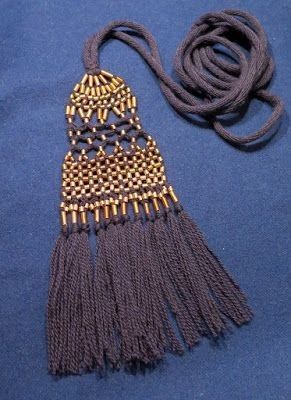
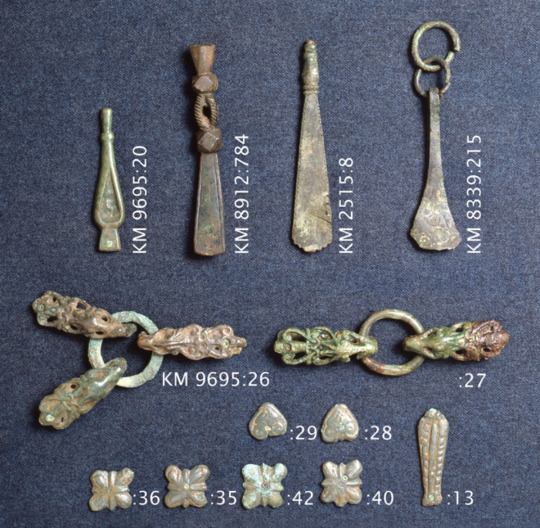
Cloak
Like women's cloak, men's cloak was woolen and either a square or trapezoid. Cloak is yet another east-west divide. In western Finland men's cloaks have embroidery with bronze spirals. They in fact appeared earlier in men's cloaks (in 900s) than in women's cloaks (1100s). They were also a little different in men's cloaks. The spirals and the patterns themselves were bigger and the fastening thread itself was also used for the pattern creation, unlike in women's dresses, where the thread was mostly covered. In eastern Finland there has been no finds of bronze decorations in men's cloaks, mostly only cloak brooches have been left of them. Unsurprisinly same applies to Karelia. This also means there's very little fabric left too. There's one exception. In Tuukkala (Savonians) they found a piece of fabric probably from men's cloak, though it could be from a men's dress too. It was striped, with possibly white or brown base and wide stripes of red, blue and yellow. So perhaps eastern Finnish cloak was not non-decorated, but the decoration was in the fabric pattern. Unfortunately it's hard to know how common fabric like that was, when so little of it is left.
Accessories
It's safe to assume men too wore some type of headwear, but none of those has survived. It probably means it was entirely made out of fabric whatever it was. Some type of hat or cap was certainly used in cold weather at the very least. Tablet woven headband was also possible option for not too cold weather.
In Tuukkala there was couple of interesting jewelry finds too. Two graves had a necklace type mostly found in Karelia. It was birchbark tape covered with nettle fabric and had square helas sewn into it. There were also more typical Finnish necklaces made of beads and bronze spirals.
Razors have also been found with men in their burials, so we can assume shaven faces or at least trimmed beards and moustaces were fashionable.
#dress history#historical fashion#historical clothing#fashion history#history#iron age dress#finnish iron age dress#finnish history#archaeology#answers#anon
227 notes
·
View notes
Text
Anyone who has spent even 15 minutes on TikTok over the past two months will have stumbled across more than one creator talking about Project 2025, a nearly thousand-page policy blueprint from the Heritage Foundation that outlines a radical overhaul of the government under a second Trump administration. Some of the plan’s most alarming elements—including severely restricting abortion and rolling back the rights of LGBTQ+ people—have already become major talking points in the presidential race.
But according to a new analysis from the Technology Oversight Project, Project 2025 includes hefty handouts and deregulation for big business, and the tech industry is no exception. The plan would roll back environmental regulation to the benefit of the AI and crypto industries, quash labor rights, and scrap whole regulatory agencies, handing a massive win to big companies and billionaires—including many of Trump’s own supporters in tech and Silicon Valley.
“Their desire to eliminate whole agencies that are the enforcers of antitrust, of consumer protection is a huge, huge gift to the tech industry in general,” says Sacha Haworth, executive director at the Tech Oversight Project.
One of the most drastic proposals in Project 2025 suggests abolishing the Federal Reserve altogether, which would allow banks to back their money using cryptocurrencies, if they so choose. And though some conservatives have railed against the dominance of Big Tech, Project 2025 also suggests that a second Trump administration could abolish the Federal Trade Commission (FTC), which currently has the power to enforce antitrust laws.
Project 2025 would also drastically shrink the role of the National Labor Relations Board, the independent agency that protects employees’ ability to organize and enforces fair labor practices. This could have a major knock on effect for tech companies: In January, Musk’s SpaceX filed a lawsuit in a Texas federal court claiming that the National Labor Relations Board (NLRB) was unconstitutional after the agency said the company had illegally fired eight employees who sent a letter to the company’s board saying that Musk was a “distraction and embarrassment.” Last week, a Texas judge ruled that the structure of the NLRB—which includes a director that can’t be fired by the president—was unconstitutional, and experts believe the case may wind its way to the Supreme Court.
This proposal from Project 2025 could help quash the nascent unionization efforts within the tech sector, says Darrell West, a senior fellow at the Brookings Institution’s Center for Technology Innovation. “Tech, of course, relies a lot on independent contractors,” says West. “They have a lot of jobs that don't offer benefits. It's really an important part of the tech sector. And this document seems to reward those types of business.”
For emerging technologies like AI and crypto, a rollback in environmental regulations proposed by Project 2025 would mean that companies would not be accountable for the massive energy and environmental costs associated with bitcoin mining and running and cooling the data centers that make AI possible. “The tech industry can then backtrack on emission pledges, especially given that they are all in on developing AI technology,” says Haworth.
The Republican Party’s official platform for the 2024 elections is even more explicit, promising to roll back the Biden administration’s early efforts to ensure AI safety and “defend the right to mine Bitcoin.”
All of these changes would conveniently benefit some of Trump’s most vocal and important backers in Silicon Valley. Trump’s running mate, Republican senator J.D. Vance of Ohio, has long had connections to the tech industry, particularly through his former employer, billionaire founder of Palantir and longtime Trump backer Peter Thiel. (Thiel’s venture capital firm, Founder’s Fund, invested $200 million in crypto earlier this year.)
Thiel is one of several other Silicon Valley heavyweights who have recently thrown their support behind Trump. In the past month, Elon Musk and David Sacks have both been vocal about backing the former president. Venture capitalists Marc Andreessen and Ben Horowitz, whose firm a16z has invested in several crypto and AI startups, have also said they will be donating to the Trump campaign.
“They see this as their chance to prevent future regulation,” says Haworth. “They are buying the ability to avoid oversight.”
Reporting from Bloomberg found that sections of Project 2025 were written by people who have worked or lobbied for companies like Meta, Amazon, and undisclosed bitcoin companies. Both Trump and independent candidate Robert F. Kennedy Jr. have courted donors in the crypto space, and in May, the Trump campaign announced it would accept donations in cryptocurrency.
But Project 2025 wouldn’t necessarily favor all tech companies. In the document, the authors accuse Big Tech companies of attempting “to drive diverse political viewpoints from the digital town square.” The plan supports legislation that would eliminate the immunities granted to social media platforms by Section 230, which protects companies from being legally held responsible for user-generated content on their sites, and pushes for “anti-discrimination” policies that “prohibit discrimination against core political viewpoints.”
It would also seek to impose transparency rules on social platforms, saying that the Federal Communications Commission (FCC) “could require these platforms to provide greater specificity regarding their terms of service, and it could hold them accountable by prohibiting actions that are inconsistent with those plain and particular terms.”
And despite Trump’s own promise to bring back TikTok, Project 2025 suggests the administration “ban all Chinese social media apps such as TikTok and WeChat, which pose significant national security risks and expose American consumers to data and identity theft.”
West says the plan is full of contradictions when it comes to its approach to regulation. It’s also, he says, notably soft on industries where tech billionaires and venture capitalists have put a significant amount of money, namely AI and cryptocurrency. “Project 2025 is not just to be a policy statement, but to be a fundraising vehicle,” he says. “So, I think the money angle is important in terms of helping to resolve some of the seemingly inconsistencies in the regulatory approach.”
It remains to be seen how impactful Project 2025 could be on a future Republican administration. On Tuesday, Paul Dans, the director of the Heritage Foundation’s Project 2025, stepped down. Though Trump himself has sought to distance himself from the plan, reporting from the Wall Street Journal indicates that while the project may be lower profile, it’s not going away. Instead, the Heritage Foundation is shifting its focus to making a list of conservative personnel who could be hired into a Republican administration to execute the party’s vision.
64 notes
·
View notes
Text
[Missing-Link] CBT2 Info
The second closed beta test has begun! This post will be updated as I spot info worth sharing (and when I'm available). Apologies for any weird formatting.
[CBT1 info] for reference. I don't expect any huge changes, however.
Character customization
Voice options
Voice samples (From what I know, it's JP voices in both JP and EN versions. No idea if we'll get EN or other languages.)
New default outfit
Hair colour, heterochromia
UI
Most elements can be moved to your liking (Was in CBT1 but I forgot to include it in that post...)
A bunch of Pieces and their ability icons
Gameplay
Environmental walking sfx
Moogle Shop (Purchase with jewels, free daily item)
Emotes (For your profile at least)
> Animated
Activity log with rewards
Fortune's Gear evolution stages (+1, +2)
Gacha
Standard banners have no pity, 10-draws guarantee a rate-up Piece
This Dark Riku Piece is only available from clearing Behemoth raids with a low drop rate; it cannot be pulled via gacha
Story (Spoilers)
Chapter names (Shipwrecked, Tracker, Society, Astral Plane, The World of Distortions)
All cutscenes (JP voice, EN sub) - lots to unpack
Some translations of the Scala text seen in one of the cutscenes
Other Stuff
Stickers (that will be very familiar to the KHUx players)
Stop playing and go touch some gra-- wait.
Bugs and other Issues
Black screen after character creation
103 notes
·
View notes
Note
de ce ai un rain world oc pe nume fat frumos please i must know (also zmeu. i see what you did there)
oh am i excited to talk about this. buckle in because it is a bit much
preemptive tldr: i have a rainworld adaptation of the făt-frumos tales where f-f stars as an overly prideful slugteen (pictured below looking moody) getting a body horror-y reality check

so! the name of this adaptation is the împărăție colony and as mentioned above its my little for-fun project based off of the original făt-frumos stories. for those who don’t know, f-f is a romanian folkloric character
some elements were changed (f-f is no longer the son of a king because there’s only one slugcat colony in this region, so i could only have a prince or a princess but not both if i wanted to keep the generic romance plot) but most were preserved, with f-f still having calul năzdrăvan (now a noble blue lizard steed inherited from his father) and with there still being the classic villains such as both balaur (infamous mutated red lizard) and zmeu (random iterator the slugcats abstracted into the Big Bad)
the story goes that the local iterator is collapsing and its bioprinters have gone haywire, so now it bleeds out nasty and highly mutagenic sludge. the local slugcat colony has not taken kindly to the deadzone and mutated fauna, but they also dont really understand what a bioprinter or hazardous chemical agent is, so they formed a mythological universe around the iterator
his name is zmeu, he’s a wretched 6 legged monster, he’s bleeding poison, he’s representative of all ill will and evil in the world, and all of his children are accursed nightmares. anything that’s been afflicted by zmeu gets the misnomer “child of zmeu” (misnomer because almost every "child of zmeu" was not born that way)
so in comes f-f: he’s the son of rege (who is again not actually the king), and rege was renowned for his incredible fighting prowess until the balaur got the best of him and left him unable to fight like he used to. f-f isn’t supposed to step up to his fathers position yet but his dad’s hand is forced, so he hastily passes on his trusted lizard (calul) and goes hey son, surprise! youre taking the mantle effective immediately
f-f eventually ends up on a mission to go slay zmeu and to find ileana, the colony leader’s daughter, who had gone missing very recently and who f-f also happens to have a fat crush on. so boldly he sets off with calul năzdrăvan
the story starts off very lighthearted and in its own head– f-f is young, rowdy, concerned with superficial things, and he’s had his ego gassed up by his colony which has its emphatic faith in him. he’s in a total fantasy world off to slay this big monster and come home as the hero with the girl, but as the story goes on, things get too real for him. balaur hunts him relentlessly and tests his grit, he sees the extent of the pollution and the environmental havoc, everything he's heard in mythos becomes less of a concept and more a frightening reality, and surviving in rainworld is just plain difficult, so his self confidence wanes. it reaches a breaking point when he eventually finds ileana, who is by now to his horror a child of zmeu
he does find his way to zmeu’s puppet chamber but it doesnt bring him any sense of completion. his only real options are to leave empty handed or to “kill” the puppet, both of which don’t solve anything... its all in all not a fun time but it teaches him some really important lessons about humility and about how small he really is in the world
its not a narratively complex or serious story and it can be cliché or even nonsensical at times, but i have a lot of fun with the characters, and im entertained by the idea of morphing a fun and shallow fantasy shindig into something frightening and slightly depressing over time
(also this ask reminded me to go back and add zmeu to the colony tag, thank you!)
#+ theres nothing better than having a character named “horse” who is not even close to a horse#quite a few smaller details have been omitted here but its more than long enough. you get the idea#ive been wanting to do individual character bios for each of the characters for a while to get a more in depth look at their personalities#maybe i can get to that now im on break and have more free time than i know what to do with#ask#lorepost#rainworld#imparatie colony#împărăție colony#edit: forgot to oc tag for the picture#oc: făt-frumos#oc: f-f#oc: cal#oc: calul năzdrăvan
29 notes
·
View notes
Text
What cars would all the little character in Hazbin Hotel drive?
I do this thing where people will send me their original characters, be they fursonas or self-inserts or fanfiction characters or whatever, and I'll figure out what kind of car that character drives! I take into account the character's design, environment, and personality all into account. It's a lot of fun! Anyways, I still have Hellaverse brainrot, so here is the main cast of Hazbin and all of their cars.

Angel Dust gets the ultimate "Gender? I hardly know her!" car,

The Mazda MX-5 Miata. Small, Adorable, Feminine, but wickedly capable and oozing with self-satisfied Charisma.

Husk has to wake up, every single day, and deal with this.

a 2010 Dodge Dakota midsized pickup. It's got 328,000+ Kilometers on it and you can *tell*. The bed is perpetually full of empty liquor and motor oil bottles, and the air conditioning doesn't work which, in hell, is a bit of an inconvenience.

Niffty! The homicidal housemaid.

Niffty doesn't strike me as a car owner. I have a much easier time picturing her absolutely RIPPING through a pedestrian-only area in any major European city.

I would never forget my main man, Alastor.

Alastor will not settle for anything but the best of the absolute best. Some would say that's a Rolls-Royce, but Alastor is American, and wouldn't be caught dead in anything from Britan. That's why he rides around in his 1929 Duesenberg Model J.

Sir Pentious has a very distinct character. Originally I was gonna work off the snake theme, but cars with snake names are just, too cool for him? Dodge Viper, Shelby Cobra, Mustang Super Snake, it just doesn't work.

Sir Pentious would drive a Jaguar X-type. He thinks the Jag makes him look evil, because it's a Jag and there is no more roguish car than that (except maybe a Camaro), but the X-type is a total pile. Based off a European Ford Mondeo and crafted about as well as a McDonald's toy. Plus, the Jag has plenty of room in the back seats for his egg boiz.

Vaggie was one of the easiest.

She's practical, utilitarian, tough, and gay. Jeep TJ.

Charlie! The main G.

Charlie would certainly drive a Volkswagen Beetle. It's perfect for her. Because yes, Charlie has a very cute and seemingly kind appearance, but she's literally the child of Lucifer. Just like how the beetle may be cute and a darling of hippie culture, it was also literally designed by Hitler*
That's the main cast! But wait! There's more!

Lucifer! There aren't many cars he actually likes, but he has found the most evil and unassuming vehicle there is.

The Tesla Model S Plaid. Sure, it may seem like an environmentally conscious choice, but the Model S Plaid is anything but "good". Able to hit 100km/h in 2.1 seconds with a rated output of 1,020 horsepower, the Plaid is a powerhouse. It can accelerate into a becoming a 5,000 pound projectile at a moment's notice, and don't think it's good for the planet either, the batteries contain various rare elements such as cobalt which Lucifer is very pleased with the dismal working conditions at the mines.
Thanks for reading! If you have more characters you wanna know what cars they drive, send me an Ask!
#*Hitler comissioned the beetle and penned the first sketch of the shape and is quoted as saying it should look like a beetle.#angel dust#sir pentious#hazbin hotel#alastor#charlie morningstar#vaggie#niffty#hazbin husk#cars
22 notes
·
View notes
Note
I have a bit of a weird question. I've been wanting to learn how to draw. I love your style and it looks like I got transported into a new world when I see your drawings. I just wanted to ask how did you find your style? What were your inspirations for drawing? Lastly, what would you recommend for a newbie like me who wants to learn how to start.
not a weird question at all, and thank you for the kind words on my art !!!! :3
my art style, as unfortunate of an answer as it is, has just developed over the past like decade of drawing. i read a lot of comics and they are definitely my main inspirations for art. jamie hewlett is my favorite artist of all time, another one of my favorites is katsuya terada.
but for inspo, my biggest go-to is comics and concept art books! i try to take elements from indie comics or like environmental/background concept art and implement that into my art in a way that fits.
and then for new artists, again, kind of shitty answer but: draw A Lot. theres no improvement when you dont draw, so even if you think its shitty or bad, keep doing it!!! also… Learning the basics is very, very helpful. learning perspective or anatomy doesnt seem like fun, but getting the basic concepts of both of those makes it so much easier to draw whatever you want. i thought i knew what i was doing and then i took classes on both anatomy and perspective and realized i actually didnt know a whole lot (not saying you need to take classes, i was just refusing to learn before)
im sorry if those werent the most helpful, specific, or revolutionary answers! im by no means a professional but i do appreciate the question nonetheless 🥲 and i hope that the advice aids you in some way on your art journey !!!
20 notes
·
View notes
Text
Writing Psychological Horror Is Hard
Writing horror is hard for me.
I think it is perhaps the clearest example, at least when I'm the subject, of the difference between being the author and being the audience. I find it extremely difficult to know what will creep out someone who doesn't know all the behind-the-scenes details of what is happening. This is despite my considerable experience as a consumer of [psychological / environmental] horror media.
When I think about the things that scare me, or maybe "unsettle" is a better word, it usually comes down to two things: 1) narratively plausible violations of the laws of nature; and 2) foreboding, i.e. the slow-building setup that something bad is coming—something that is specific enough to be apprehensible but still ambiguous enough to be cloaked in mystery.
But! Not just any attempt at these things will actually work. There is definitely a secret sauce that makes some efforts fail and others succeed.
In the game Oxenfree, probably my favorite horror game of all time, there is a scene on the "Find Clarissa!" subplot where Alex et al. are in something akin to a classroom in an abandoned military base on an uninhabited island, and a discordantly upbeat and normal-sounding midcentury-style gameshow host is talking to them through a haunted radio asking them questions in a game of Hangman (whose figure is gradually being drawn by invisible means on the chalkboard), while a lamp overhead illuminates the room in a very unnatural light as it swings back and forth for no apparent reason. And this was one of my favorite moments in the entire game, because it was really scary. It benefitted from the existing atmospheric horror build up in the events immediately preceding it, and also benefitted from not being a narrative climax; it actually ratchets up the tension in the story even higher, without resolving anything (other than itself).
But I think that if you went purely by my description, you would be hard-pressed to create a scary implementation of this scene. I certainly would be—and I know that for a fact, because I have more or less tried it!
What is it that makes something profoundly unsettling in that oh-so-delicious manner of a good horror story? Well, the academic answer is that it's appealing to our instincts of danger: dangerous environments (like rocks or cliffs or plants, or, indeed, "the dark"), dangerous predators, dangerous people, dangerous forces (like fire and wind and water), and dangerous sicknesses (e.g. infectious disease). Most horror taps into at least one of these primal apprehensions in the human psyche. And to succeed it has to feel real, the way a roller coaster feels like you're really falling. But I don't think "the academic answer" really sheds all that much light on the mystery of actually composing horrifying situations and events.
A lot of the craftsmateship is a balancing act.
For example: You don't want to hit the audience over the head with obvious bogeymates—jumpscares for the sake of jumpscares, as it were, or having your big scary cryptid jump out in its full costume in broad daylight and look absurd—but I have also found, through experience, that it is very easy to hide horrifying details too well, to be too subtle about it—and it is extremely difficult for me to get a sense, on the audience's behalf, of how subtle is too subtle.
That leads me to an important insight: Part of the secret sauce of horror is contextually embedding horrifying story elements into a broader context. A "haunted stick of furniture" isn't going to get many people a-quailin' in their boots. It has to be more about how that object is embedded in the story. You know, like a haunted couch, or a haunted table: How do you make that scary? I don't think it can be scary on its own. Not consistently and convincingly. Instead you have to set it up ahead of time in some way(s), by providing information to the audience that you are then going to subvert or manipulate later. Yet it is all too easy to do this in a way that comes across like a paint-by-numbers exercise: "Wait a minute! Wasn't this couch pointing the other way earlier?! GASP!!" No one is gonna be scared by that. It's not enough.
Ultimately, I think scaring people successfully, in the psychological horror sense, therefore involves an element of overwhelming their ability to cope with and anticipate environmental changes, which assumes an elaborate environmental structure that you're going to have to set up, in non-obvious ways, earlier in the story. You have to give them expectations about how things will change and then either gradually go beyond that magnitude of change or else go in a different direction of change entirely—usually the former. Psychological horror is all about the fear of the jumpscare that never comes.
But I'm also just spitballing for the purposes of this essay. I don't really know. I struggle with this stuff!
It really is an art form to be able to scare people in this way.
Additional, medium-specific difficulty comes in the fact that the written media that I work in does not have access to a scary soundtrack or sound effects or voices, or to scary visuals and visual effects. Written text does have the corresponding advantage of having unfettered access to the reader's imagination, allowing them to essentially self-select the personally scariest interpretations of some of the details of a scene. But taking full advantage of this power is not easy at all; you have to put the right kinds of details in, and you have to do so in a digestible format, all without cluttering the flow of the story.
I have been doing a lot of Galaxy Federal writing lately, and have been trying to write some of the "scarier" bits and pieces in it, and I almost resent how totally clueless I am in regards to whether I am hitting the mark to my satisfaction! 😮
38 notes
·
View notes
Text
ok so i just watched the wicker man (the original one ofc not that awful nicholas cage remake with the bees lol) and rather than making a post about it i ofc am gonna talk about mr king, aka the in9 episode that people kept saying was super similar to the film lol because if i cant relate everything to my hyperfixation then what is the POINT lol?!
first thing i will say is i absolutely LOVED the film!! i often find classic horror films either to be hit or miss (halloween sucked but the exorcist was amazing lol) and this was definitely a hit imo!
and it's super interesting thinking back to mr king and the things they chose to pay homage to from the original! creepy kids, masks and rituals, emphasis on sexuality and the harvest, even the outsider acting as a 'well-meaning coloniser' trying to 'educate' the natives lol
but i think it's in the changes that make mr king super interesting to me (and why it kinda bugs me that people keep just saying it's a remake of the wicker man... like it bugged me BEFORE i watched the film and even more now because they are v different lol something being inspired by a thing doesn't mean it's copying it smh have y'all never heard of a homage!?!?... anyway)
changing the setting to wales was SUCH a good choice imo, a place that is only really recently beginning to properly reclaim some of it's old culture after literally centuries of english colonisation (if you weren't aware, there have been recent pushes for various welsh landmarks and places to be referred to by the welsh name and not the english, which i wholeheartedly support tbh! you can't pronounce yr wyddfa? skill issue lol), and moving the focus from religion to environmental factors also made so much more sense for something set this century!
i also found it interesting the way both deal with the weaponisation of sex and sexuality... in the film it's when the landlord's daughter (willow) tries to seduce the sergeant in order to expose his hypocrisy (and ironically in not giving into it, he sealed his own fate in the end lol), and in the show it's the young girl who lies about alan being sexual towards her (in turn leading towards the whole photograph scene and, ultimately, his own grizzly end lol)... both in a way are responding to the culture of their respective times (the film commentating on the 60s/70s free love culture, mr king responding to the wider #me too movement of the last 10 or so years)
and continuing on from this, part of the horror in both speaks specifically to the audience's discomfort with open discussions and displays of sexuality, and the power that that discomfort holds over us still... and ofc in the film this manifests itself with the idea of christianity vs paganism, highlighting how both are a lot more similar than either side would like to admit to lol...
mr king is a little more murkier, since the emphasis is on environmentalism. in a way it deals a lot more with the concept of rationality (as in, science and the like) vs irrationality (as in, paganism and mysticism) than the original! though in the end the message is the same: that regardless of what or who you believe in, it ain't gonna stop you from being murdered lol! it also positions that in the mr king universe, the sacrifices aren't just the town trying to come back from a bad harvest, but instead a super important yearly ritual that, presumably, is actually working lol?? so what we may perceive as 'irrational' is actually the other way around lol...
one of the big changes from the film is the mystery element. in the film sergeant howie's whole deal is that he's gone to the island to find a young girl... in fact the town's people specifically use the fact they know he will stop at nothing to save her (even by the most degrading and invasive ways possible) as a way to trap him. alan is completely different in this regard, in that he has come to rural wales in order to escape his old life... he's not trying to save anyone, effectively he's running away! and even the mystery of the previous 'mr king' is only really something he looks into to save his own skin... both characters are selfish in the reasons why they end up in their positions, and naive to think that their positions as men in positions of authority would save them!
idkk i just think there's a lot of super fascinating stuff in this episode and how it plays with the aesthetics and themes of the film it was inspired by that i've just kind seen brushed aside just cos the 'twist' at the end was super similar to it lol??
#inside no 9#mr king#the wicker man#in9#i have NO idea if this makes any sense lol#also it's been a while since i rewatched mr king so i hope i didnt get any of the details wrong pfft#there was also more i wanted to say with like the queer elements of both? and comparisons between steve's character#and christopher lee's in the original but this post is long enough already pfft#anyway plz let me know ur thoughts about this ep if u have any!#i hardly see anyone talk about it tbhh
20 notes
·
View notes
Text
More thoughts about Satine’s pacifism…
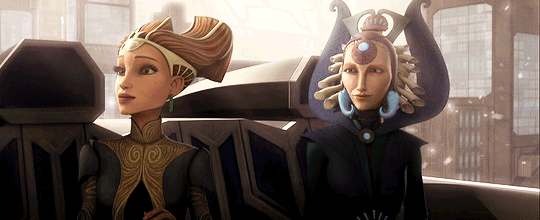
So I read this post the other day that suggested Satine’s period of rule was just a blip in Mandalore’s history, that she only maintained power because she’d won it in battle, and that Mandalorians were glad to return to their traditionalist ways and… it just really irked me.
Because that’s not true at all??
When we meet Satine in TCW, it’s super clear that she was very popular, and a good ruler. In only 15-20 years, she’s restored Sundari to prosperity, and is a city that appears very wealthy with a satisfied population. She herself is very invested in her people, helps directly with social and political matters. She’s managed to rebuild worlds and cities devastated by war and environmental issues.
There’s never any kind of explanation exactly as to her style of rule. Certainly she’s not a constitutional monarch but there is a prime minister and council, and regional governors, so she’s no autocrat. This suggests democracy, and her people thus voting for continued pacifist policies/leaders.
(We also only see issues/events occur that in any society would involve leaders, regardless of how much a role they play in politics)
I mean sure, it’s the capital city and we don’t really see anywhere else. And there’s also corruption, hunger, terrorism, etc.- but a lot of the latter issues are because of outside forces (galactic war and the sith) that she does remarkably well, in my opinion, to combat for several years.
So already that’s a lot of evidence to suggest pacifism/modernism was widely popular amongst Mandalorians and not just a blip.
(Also, she may have come to power through battle, but this suggests there was an incredibly strong military and public force behind her ascendancy to the throne in order to win a civil war that had been waging essentially for decades- therefore illustrating mandalorians wanted pacifism, and she didn’t just usurp her position)
Then to the suggestion they were glad to return to their military ways…
People often use the state of Mandalore in Rebels/The Mandalorian to argue that the warrior culture was a more natural and preferred one among Mandalorians.
But this isn’t what we see at all.
We return to Mandalore in Rebels like 17/18 years after we last saw it in TCW. In this time, an extremist clan and the empire have been ruling the system.
We’ve seen the scale and ability of the empire’s propaganda missions already- erasing or changing history, destroying entire races- particularly with the jedi.
Alongside a ruler encouraging/forcing his people to re-embrace their martial past, of course it’s going to appear as if Mandalorian society has returned to its ‘original’ state of violence and warfare.
And yet, even though it’s gone back to clan warfare and endless, unnecessary fighting, that’s not what the people want at all.
Even though the Mandalorians we meet in Rebels are characterised as especially traditional (clan wren allied with death watch; fenn rau fought alongside the republic and later the empire, going against satine’s political status) they are never actually fighting for a return to their martial past.
Instead, the whole storyline is about uniting Mandalorians, pushing out the oppressive empire, ending the civil wars, etc.
Sure, they want to retain more of their martial culture than Satine did, but perhaps here is where we can argue that Sundari was a bit of an exception by being so especially modernist, whereas other planets and communities still retained many elements of their warrior culture- such as wearing the armour- even if not engaging in warfare.
Again, there is a similar storyline in The Mandalorian season 3- despite the fact that this is about the most extreme group of Mandalorians. It’s still about uniting together, rebuilding their world, ending war and violence among each other, protecting each other.
Therefore, I think it’s clear that actually, even if not to quite the same degree (but then, it’s likely this would come later once the last 2 decades of military propaganda had been overcome) Mandalorians didn’t want to retain their military past, but wanted to move in a more pacifist direction.
The only thing I have some issue arguing against is what we see in TCW when Satine is overthrown, where the masses really quickly switch to supporting death watch/Vizsla.
I’ve talked here about why this may be the case but even many of my arguments on that post don’t properly explain why a city that in previous seasons we saw offering mass support for satine and prospering under pacifism, suddenly turned so against her.
Really, I put this down to TCW being, in the end, a show aimed at younger audiences, and needing to get the point across clearly and dramatically that death watch and maul had manipulated people, and that’s why it seems so out of place.
(Does anyone have more to say on this than me? I’d find other’s perspective on this, whatever that perspective is, really interesting)
Either way, it’s made continually clear that Satine’s rule was far from a blip in Mandalorian history, or that Mandalorians only ever barely tolerated her.
Their martial society was a thing of the past. People were sick of it. Satine won the clan wars for a reason, and was a very effective ruler for many years until events outside her control (that frankly would have negatively impacted even the most golden ruler) meant she fell from power.
Had there not been the clone war or the sith, she would undoubtedly have continued to rule, and mandalore continued to stay pacifist.

(I also think it’s a shame we never saw more of mandalorian society during Satine’s rule. We only focus on her and other political rulers at that time, and when we later return to mandalore it’s all from the perspective of either extremists like din djarin and his sect, or again more political leaders/rulers that have an especially militaristic past.)
#star wars#satine kryze#mandalore#duchess satine kryze#the clone wars#bo katan kryze#death watch#sundari#pacifism#satine pacifism#pre vizsla#sw rebels#clan wren#ursa wren#sabine wren#sabine rebels#the mandalorian#din djarin#the armourer#star wars thoughts#star wars tcw#padme amidala#almec#fenn rau#darth maul#star wars maul#the great clan wars#the siege of mandalore#the darksaber
154 notes
·
View notes
Note
hi!! i gave this a lot of thought before sending this ask cause it's kinda embarrassing—which is why i appear as anon 😭. english isn't my first language so i'm sorry if this reads weird since i struggle with wording!
soo, in late december i started writing fanfiction in english, hl to be precise! mostly for shits and giggles and because i couldn't find what i wanted to read so i thought "wth i'll do it myself". (i used to write when i was 12 but not in english and very much like shit so then i just stuck to reading)
the thing is, i can defend myself enough when it comes to english, but now that i'm writing in it i STRUGGLE so much to put my thoughts into text (description-wise, to be precise) that i need references; so i started using AI—now, don't get me wrong; it's not like i just c&p whatever it gives me because it sounds robotic af, but it does help with wording. i also take references from books and fics i've read if i like the person's writing style! like if somebody had a cool way or word to say "the sky is blue" i'd have it in mind haha
i honestly have no intentions of ever publishing it (and if i've ever did i'd disclose it) but the other day i saw a post where people said they disliked anything to do with AI and i completely understand cause me too, and while i don't straight up, i still used it as a part of the process so it feels like i'm a fraud :(
i've never told this to anyone since i don't have anybody to, nor i am in any communities, and if i was i'd be scared to get called out for this?? anyway i know this might've been a bother to read, so, sorry for that!
on another note, your writing style is fucking fire and i love it!! 🫶🏻
Hi anon! First off, thank you for the kind words! I appreciate you taking the time to read my work.
I also appreciate your honesty and willingness to acknowledge the ethical dilemmas around the use of AI in creative work. And your point actually provided me with a really important consideration I hadn't thought of.
Gonna put my thoughts under a cut because I have a lot of them. 😬
For some background, I have a journalism degree and currently work in social media, so the debate around AI is something that's become a constant in my industry. I don't use it at work due to ethics. I also don't use it in my writing because I need the challenge and creative outlet.
So for the longest time, I've been very anti-AI in creative work, and for the most part, I still am. I believe we should pay creators for their work and appreciate the human elements and perceptions they provide. For instance, a computer can aggregate and repurpose prose about how it feels to watch your father die, but a computer can never actually put that feeling into words -- its interpretation will always be a superficial regurgitation of others' work. So I've always viewed AI as more of a tool that should be used to improve health care and medicine, accessibility inequities, and minimizing data errors. Plus, the environmental impact is really alarming.
But you make a really astute point about your use of AI to write in a language that isn't your first. As someone who only really ever speaks and writes in English as a first language, I admittedly hadn't considered how a writer like you can benefit from AI to better learn how to craft prose in a different language. If I needed to write my stories in a secondary language, I'd certainly want help in learning to write them in a way that isn't basic, elementary sentence structure, and not everyone has the means to take English classes and creative writing courses.
So yes! I think your use of AI as an educational tool to become a better writer is fair. Like you said, it's not like you're copy-and-pasting AI-generated work and publishing it as your own, nor are you calling that work your finished process. If you’re using it for grammatical support and not to craft your prose, you’re not a fraud. Also, the fact that you're learning to write in English is really impressive since the English language is so nuanced.
Anyway, just keep writing! And read, too -- one of my professors always used to say you'll never write as well as you read. Keep going, I'm sure your work is great, and I appreciate you for loving your creative process enough to keep working at it!
7 notes
·
View notes
Text
All the books I reviewed in 2023 (Graphic Novels)

Next Tuesday (December 5), I'm at Flyleaf Books in Chapel Hill, NC, with my new solarpunk novel The Lost Cause, which 350.org's Bill McKibben called "The first great YIMBY novel: perceptive, scientifically sound, and extraordinarily hopeful."

It's that time of year again, when I round up all the books I reviewed for my newsletter in the previous year. I posted 21 reviews last year, covering 31 books (there are two series in there!). I also published three books of my own last year (two novels and one nonfiction). A busy year in books!
Every year, these roundups remind me that I did actually manager to get a lot of reading done, even if the list of extremely good books that I didn't read is much longer than the list of books I did read. I read many of these books while doing physiotherapy for my chronic pain, specifically as audiobooks I listened to on my underwater MP3 player while doing my daily laps at the public pool across the street from my house.
After many years of using generic Chinese waterproof MP3s players – whose quality steadily declined over a decade – I gave up and bought a brand-name player, a Shokz Openswim. So far, I have no complaints. Thanks to reader Abbas Halai for recommending this!
https://shokz.com/products/openswim
I load up this gadget with audiobook MP3s bought from Libro.fm, a fantastic, DRM-free alternative to Audible, which is both a monopolist and a prolific wage-thief with a documented history of stealing from writers:
https://pluralistic.net/2022/07/25/can-you-hear-me-now/#acx-ripoff
All right, enough with the process notes, on to the reviews!

GRAPHIC NOVELS
I. Shubiek Lubiek by Deena Mohamed

An intricate alternate history in which wishes are real, and must be refined from a kind of raw wish-stuff that has to be dug out of the earth. Naturally, this has been an important element of geopolitics and colonization, especially since the wish-stuff is concentrated in the global south, particularly Egypt, the setting for our tale. The framing device for the trilogy is the tale of three "first class" wishes: these are the most powerful wishes that civilians are allowed to use, the kind of thing you might use to cure cancer or reverse a crop-failure.
https://pluralistic.net/2023/01/11/your-wish/#is-my-command
II. Ducks by Kate Beaton

In 2005, Beaton was a newly minted art-school grad facing a crushing load of student debt, a debt she would never be able to manage in the crumbling, post-boom economy of Cape Breton, Nova Scotia. Like so many Maritimers, she left the home that meant everything for her to travel to Alberta, where the tar sands oil boom promised unmatched riches for anyone willing to take them. Beaton's memoir describes the following four years, as she works her way into a series of oil industry jobs in isolated company towns where men outnumber women 50:1 and where whole communities marinate in a literally toxic brew of carcinogens, misogyny, economic desperation and environmental degradation. The story that follows is – naturally – wrenching, but it is also subtle and ambivalent. Beaton finds camaraderie with – and empathy for – the people she works alongside, even amidst unimaginable, grinding workplace harassment that manifests in both obvious and glancing ways.
https://pluralistic.net/2023/01/14/hark-an-oilpatch/#kate-beaton
III. Justice Warriors by Matt Bors

Justice Warriors is what you'd get if you put Judge Dredd in a blender with Transmetropolitan and set it to chunky. The setup: the elites of a wasted, tormented world have retreated into Bubble City, beneath a hermetically sealed zone. Within Bubble City, everything is run according to the priorities of the descendants of the most internet-poisoned freaks of the modern internet, click- and clout-chasing mushminds full of corporate-washed platitudes about self-care, diversity and equity, wrapped around come-ons for sugary drinks and dubious dropshipper crapola. It's a cop buddy-story dreamed up by Very Online, very angry creators who live in a present-day world where reality is consistently stupider than satire.
https://pluralistic.net/2023/05/22/libras-assemble/#the-uz
IV. Roaming by Jillian Tamaki and Mariko Tamaki
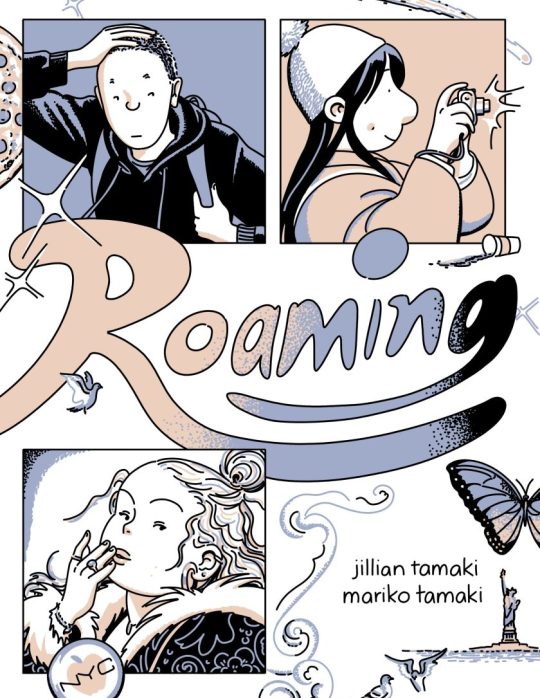
The story of three young Canadian women meeting up for a getaway to New York City. Zoe and Dani are high-school best friends who haven't seen each other since they graduated and decamped for universities in different cities. Fiona is Dani's art-school classmate, a glamorous and cantankerous artist with an affected air of sophistication. It's a dizzying, beautifully wrought three-body problem as the three protagonists struggle with resentments and love, sex and insecurity. The relationships between Zoe, Dani and Fiona careen wildly from scene to scene and even panel to panel, propelled by sly graphic cues and fantastically understated dialog.
https://pluralistic.net/2023/09/11/as-canadian-as/#possible-under-the-circumstances

Like I said, this has been a good year in books for me, and it included three books of my own:
I. Red Team Blues (novel, Tor Books US, Head of Zeus UK)

Martin Hench is 67 years old, single, and successful in a career stretching back to the beginnings of Silicon Valley. He lives and roams California in a very comfortable fully-furnished touring bus, The Unsalted Hash, that he bought years ago from a fading rock star. He knows his way around good food and fine drink. He likes intelligent women, and they like him back often enough. Martin is a—contain your excitement—self-employed forensic accountant, a veteran of the long guerilla war between people who want to hide money, and people who want to find it. He knows computer hardware and software alike, including the ins and outs of high-end databases and the kinds of spreadsheets that are designed to conceal rather than reveal. He’s as comfortable with social media as people a quarter his age, and he’s a world-level expert on the kind of international money-laundering and shell-company chicanery used by Fortune 500 companies, mid-divorce billionaires, and international drug gangs alike. He also knows the Valley like the back of his hand, all the secret histories of charismatic company founders and Sand Hill Road VCs. Because he was there at all the beginnings. Now he’s been roped into a job that’s more dangerous than anything he’s ever agreed to before—and it will take every ounce of his skill to get out alive.
https://us.macmillan.com/books/9781250865847/red-team-blues
II. The Internet Con: How to Seize the Means of Computation (nonfiction, Verso)
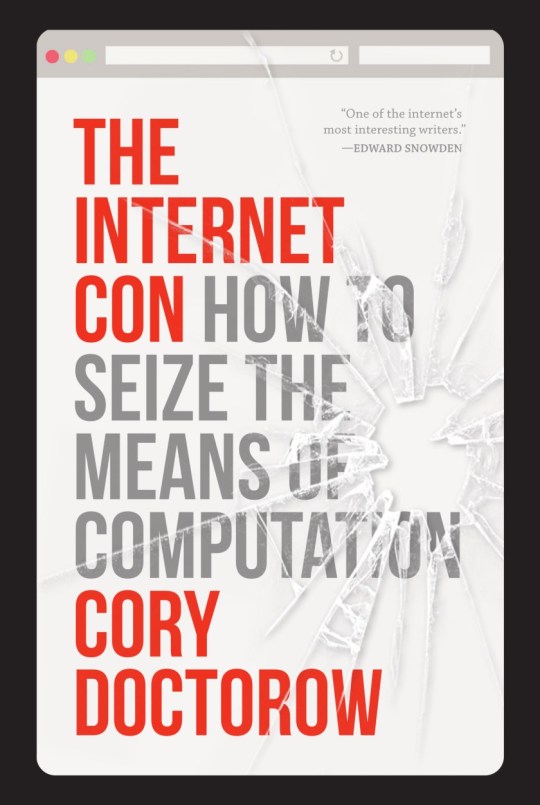
We can – we must – dismantle the tech platforms. We must to seize the means of computation by forcing Silicon Valley to do the thing it fears most: interoperate. Interoperability will tear down the walls between technologies, allowing users to leave platforms, remix their media, and reconfigure their devices without corporate permission. Interoperability is the only route to the rapid and enduring annihilation of the platforms. The Internet Con is the disassembly manual we need to take back our internet.
https://www.versobooks.com/products/3035-the-internet-con
III. The Lost Cause (novel, Tor Books US, Head of Zeus UK)

For young Americans a generation from now, climate change isn't controversial. It's just an overwhelming fact of life. And so are the great efforts to contain and mitigate it. Entire cities are being moved inland from the rising seas. Vast clean-energy projects are springing up everywhere. Disaster relief, the mitigation of floods and superstorms, has become a skill for which tens of millions of people are trained every year. The effort is global. It employs everyone who wants to work. Even when national politics oscillates back to right-wing leaders, the momentum is too great; these vast programs cannot be stopped in their tracks.
But there are still those Americans, mostly elderly, who cling to their red baseball caps, their grievances, their huge vehicles, their anger. To their "alternative" news sources that reassure them that their resentment is right and pure and that "climate change" is just a giant scam. And they're your grandfather, your uncle, your great-aunt. And they're not going anywhere. And they’re armed to the teeth. The Lost Cause asks: What do we do about people who cling to the belief that their own children are the enemy? When, in fact, they're often the elders that we love?
https://us.macmillan.com/books/9781250865939/the-lost-cause

I wrote nine books during lockdown, and there's plenty more to come. The next one is The Bezzle, a followup to Red Team Blues, which comes out in February:
https://us.macmillan.com/books/9781250865878/thebezzle
While you're waiting for that one, I hope the reviews above will help you connect with some excellent books. If you want more of my reviews, here's my annual roundup from 2022:
https://pluralistic.net/2022/12/01/bookishness/#2022-in-review
Here's my book reviews from 2021:
https://pluralistic.net/2021/12/08/required-ish-reading/#bibliography
And here's my book reviews from 2020:
https://pluralistic.net/2020/12/08/required-reading/#recommended-reading

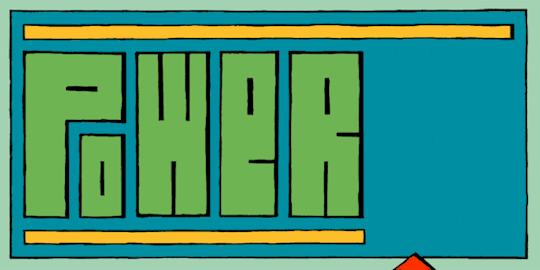
It's EFF's Power Up Your Donation Week: this week, donations to the Electronic Frontier Foundation are matched 1:1, meaning your money goes twice as far. I've worked with EFF for 22 years now and I have always been - and remain - a major donor, because I've seen firsthand how effective, responsible and brilliant this organization is. Please join me in helping EFF continue its work!

If you'd like an essay-formatted version of this post to read or share, here's a link to it on pluralistic.net, my surveillance-free, ad-free, tracker-free blog:
https://pluralistic.net/2023/12/01/bookmaker/#2023-in-review
58 notes
·
View notes